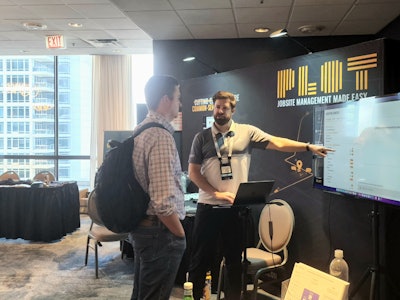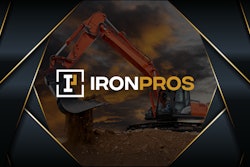
Almost 300 construction professionals packed into meeting rooms at the Voco Chicago Downtown in Chicago for the Advancing Construction Technology 2022 conference to learn mostly from their peers about each other’s technology initiatives, successes and lessons learned from false starts and betas.
The importance of a rigorous construction technology selection process and best practices for running betas and trials of construction technology were front and center in a number of the sessions, driving home the importance of the beginning of a relationship with a software or technology vendor as being central to success. Of course the question that must be handled first, and was the subject of some discussion, was whether to work with a vendor or recruit an internal department to build out a custom solution.
“I hate home baked solutions,” Haskell Company Director of Innovation Hamzah Shanbari said in an opening keynote on his company’s innovation program, which is housed in its on separate LLP within the company. “They are held together with toilet paper and spit. Everything is very fragile, anything that goes wrong is on you. I prefer to go and find solutions in the market.”
That prompted a comment from the audience from a contractor with a diametrically opposing viewpoint as their internal department is charged with creating technology that will be a differentiator for the company in the market. There is no one right solution to this conundrum, apparently.
Shanbari heads up Disruptek, an internal innovation arm Haskell founded in 2018, and is a case in point that even researching, building business cases and trialing commercial-off-the-shelf (COTS) construction technology requires effort, discipline and forethought.
“Our main mission is investing in technology,” Shanbari said. “We also do emerging technology pilots as part of a dedicated innovation program. We are open all employees to submit ideas of things to implement or change.”
Key success factors in Shanbari’s experience include:
- Dedicated funding—Disruptek will fund pilots, innovation projects and research and development efforts for Haskell.
- Consistent efforts across organizations—“We don’t want our water wastewater folks implementing stuff the healthcare people don’t even know about—there are synchronicities there we want to leverage,” Shanbari said.
- Constant reporting—in order to know what works, a contractor must document what they tested and then, objectively, how it went. This may include use of a consistent evaluation card for new technology companies so that when a pilot begins there is a clear reflection of what is being implemented.
Shanbari has a rigorous process for planning, executing and monitoring beta projects and trials, and stresses the importance of internal marketing for pilot projects and regular efforts to identify the real internal influencers who can drive a project to success by ensuring the user base engages.
“We loo for these silent field innovators who are not talking to anybody else, but are still very valuable,” Shanbari said. “How do you find those?”
For Shanbari and his team, the solution was to commission a study on innovation, and suggested those taking the survey forward it to others who ought to be included.
“We looked at all the answers on all these different tech types, and it showed people very excited about BIM, less so augmented reality or virtual reality or 3D printing. But we also were able to locate our top 50 field innovators.”
 Cupertino Electric BIM Program Manager Kelli Lubeley explains her method for calculating ROI from construction technology investments at Advancing Construction Technology 2022.Charles Rathmann
Cupertino Electric BIM Program Manager Kelli Lubeley explains her method for calculating ROI from construction technology investments at Advancing Construction Technology 2022.Charles Rathmann
A Voice for Vendors
While contractors carried most of the load in terms of presenting, vendors ranging from reality capture company OpenSpace to labor management platform Bridgit presented with customers. The exhibit hall and presentations were heavy on vendors involved with data capture and marrying that data with BIM, making this the dominant tech at the event. Apart from OpenSpace, Avvir, DroneDeploy, Pix4D, NavVis, JP Global Digital and Cupix were all on-site. Constru, a newcomer to the North American market, was also a sponsor.
Gilbane VDC Manager, Midwest Division Joe Good presented in a main session with OpenSpace, providing hints as to why data capture and related virtual design and construction (VDC) tech was center stage.
“We have been scaling and standardizing reality capture solutions,” Good said. “After COVID this technology became the new normal—it is the industry recognizing the value and being able to adjust the better managed data to the whole company. OpenSpace has been a great partner, and we feel and over the last year, OpenSpace is the lead horse in that stable. There are simple standards for information, ad we get people out there to capture data and then are able to work with that data … people have to walk the jobsite anyway, but capturing the work right when it is happening gives us faster turnaround, and then we have data we can disseminate and share.”
Gilbane has rolled out OpenSpace’s Capture product, and plans to add the company’s new progress tracking tool, ClearSight.
Tinder Rules for Construction Tech
In one session, Alberici Director of Construction Technology Brooks Williams delivered a master class in vetting and selecting software and technology partners, sharing his best practices that may also, to his point, be helpful for those using matchmaking site Tinder.
Say yes to first dates is one rule. “Look at things that don’t look like just the right fit,” Williams said. “Cast a wide net. Some vendor who may not look perfect … they may show you something from a technology perspective you had not thought of.”
Also, as with Tinder dating, ghosting is not cool, Williams said. Contractors should explain clearly to a vendor why they are not moving forward with them. Conversely, it is important to set boundaries. Vendors should not be rewarded for calling or emailing incessantly or doing end runs around the person running the selection.
“On first dates, document everything, Williams said. “I will often handle these meetings by myself—just vetting the vendor as it is a time suck to involve others. I document why this may be a fit, what’s missing, the quality of the user experience, the mobile experience if that is applicable and reporting dashboards and data extraction. I ask and record what is the pricing model. Do they have a pilot strategy?
Second dates, for Williams, include other members of the team.
“Have conversation with the team right after that group meeting when it is fresh in their minds,” Williams said. “If you wait a couple days, they will have to remember what they saw. If they are seeing more than one, it will be all muddied up in their minds.”
One thing that may not be feasible in Tinder dating but is critically important in construction technology selection is the practice of calling references. Oftentimes, vendors may provide references but not really believe you will contact them.
“The number of times I have gotten a ‘don’t do this’ email from a reference a vendor gave me is shocking,” Williams said. “Too many contractors look at that reference list and are impressed with the names. You do need to call them.”
Due Diligence Important
Williams offered helpful pointers for areas contractors should focus on for due diligence during their Tinder dating process.
“Do they have API documentation?” Williams asked. “Sometimes a vendor will say they have an API but then you ask for documentation and they say they have to get back to you. Who owns the data? What are they doing for data security? What about the company’s financial stability and ownership? Are they looking to get acquired by a larger company? What about support capabilities? If you are a larger contractor, do they have the ability to support and serve you?
Documenting what you want to achieve with a technology project or implementation and ensuring that value is realized is important, but sometimes a contractor may find benefits they did not anticipate, and that too should be documented.
“We implemented LaborCart (purchased by ProCore in 2021) and we expected it would help us know where our people were on projects But it also gave us a way to track worker certifications. We had a method for tracking this before, but it was woefully out of date and now we have a system that tracked a real person to certifications that expire. We can pull that up, and know it is up to date.”



















